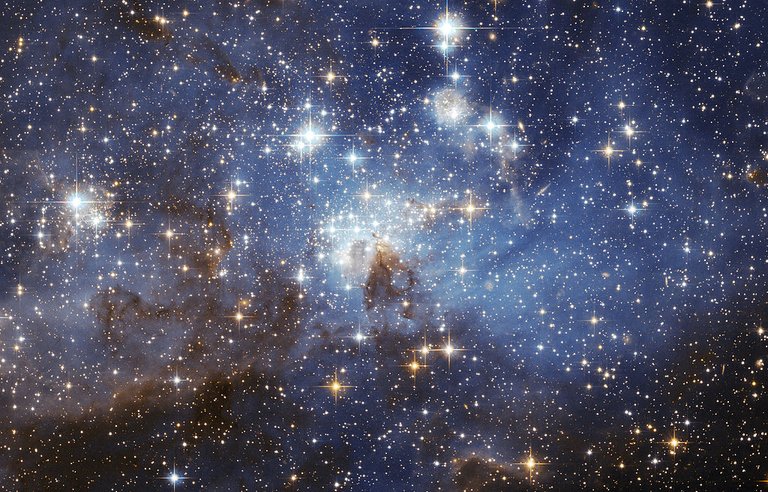
Knowledge of star structure takes a long journey. To find out, the astronomers only rely on the appearance of stars from the outside only. This paper tries to explain how the journey takes place.
What is a star?
Before diving deeper to know the star structure, one must be able to define in advance whether the star is actually based on its appearance from the outside.
Since ancient times, people have been trying to guess what is a star, the tiny light spots in the sky. That the stars are actually other suns that are very far away, already postulated by Ancient Greek philosophers, Democritus and Epicurus, and confirmed in 1584 by Italian philosopher Giordano Bruno until finally reaching consensus among astronomers a century later.
The only link between the Sun/stars and the observer is the light. To be able to answer whether the star is actually, this light is 'pierced', collected, spread again, sorted, 'spun,' and so on. Joseph von Fraunhofer in 1814, passing the sun's light on a prism. He records and maps a number of dark lines in the spectrum of the Sun, which are then referred to as Fraunhofer lines. Gustav Robert Kirchhoff and Robert Bunsen later discovered that the lines came from low-pressure gases and were associated with a chemical element located in the upper layers of the sun. Fraunhofer also later discovered that other stars also have spectra like the Sun, but with different dark stripes. So from here then astronomers came to the conclusion that the star is actually a gas ball.
The study of the spectrum of stars can reveal what elements are in the stars, but how much of this new element's abundance could be determined in 1925 after Cecilia Payne-Gaposchkin, using the ionization theory of Meghnad Saha, managed to reveal that hydrogen is the most abundant chemical element. So a star is a glowing gas sphere with hydrogen as the most abundant element.

The energy source in the stars
OK, deal, the star is a glowing gas ball with hydrogen is the most abundant element. To know the structure, astronomers approach both from the outside and from within. The external approach is as simple as the external observer. The inner approach raises an important question: what happens at the star center? Stars can shine; there must be energy that is awakened on the inside.
In the mid-19th century, Lord Kelvin and Hermann von Helmholtz, using energy conservation theory postulate that the energy produced by the Sun comes from gravitational shrinkage. The shrinking process converts gravitational energy into heat energy and raises the temperature at the core of the Sun. With the price of the Sun's mass and radius now, and then dividing it by the amount of energy it emits, the Sun's age will be obtained based on the Kelvin-Helmholtz mechanism in the 18 million year range. Of course, this is contrary to the geological and biological evidence supporting that life has been going on for billions of years and should have been there ever since. However, the Kelvin-Helmholtz mechanism was important in the early days of the Sun's formation.
The development of quantum physics spawned a new theory of energy generation in stars. It was Sir Arthur Eddington in 1920 that put forward for the first time, involving two protons that joined to form a helium nucleus followed by the release of energy. In 1939, Hans Bethe proposed a proton-proton cycle mechanism for generation of energy within a sun-tall star, complementing the theory of the carbon-nitrogen-oxygen cycle mechanism previously proposed in 1938 by Carl Friedrich von Weizsäcker.
When Eddington discloses his proposal for the first time, it is found that the pressure and temperature of the Sun are not high enough to allow the combustion of hydrogen fusion. Bethe sees that the effects of tunnels in quantum physics can overcome this problem, so that fusion reactions can occur in environments with lesser temperature and pressure. The proton-proton cycle proposed by Hans Bethe is a fusion reaction that is less sensitive to temperature and progresses slowly. This cycle also makes the stars of the sun and the smaller can be much longer.
On the other hand, the carbon-nitrogen-oxygen cycle takes place at high temperatures and pressures when kinetic energy is able to overcome the Coulomb force barrier. The carbon-nitrogen-oxygen cycle takes place at a rapid rate so that once the star has enough pressure and temperature, it will be more dominant than the proton-proton chain. With the CNO cycle, there is a kind of circular cycle, the higher the temperature, the faster the reaction takes place, and the faster the reaction progresses, the higher the temperature. This dominant cycle occurs in stars that are more massive than the sun.
The difference in the mechanism of nuclear fusion inside the star will make the difference between star structures that are smaller than the sun and larger.

Deliverance of energy
Knowing how energy is transported out of the star center is important when we want to know the star structure. We recognize various ways of energy transfer: conduction, convection, and radiation. In the star, its main energy is transported in two ways, namely convection, and radiation. The difference in the energy generation mechanisms described above makes the structure of stars of the sun and the smaller difference from the more massive stars.
Star Structure Size of Sun or Smaller

Convection occurs when there is a considerable temperature difference between two fluid layers. Gas and plasma, two substances in the star, act as fluids. In convection, energy is carried by matter moving from a high-temperature to a low layer. As discussed above, the generation of energy in stars of the sun or smaller is primarily accomplished through the mechanism of proton-proton chains that are less sensitive to temperature. This causes the temperature at the layers in the core not too different so that convection does not occur. The energy in the core is transported out by means of radiation.
Conversely, on the outside of the star, the temperature is low enough to allow the hydrogen atom to be in a neutral state. At one point in the star between the core and the surface, the high-energy photons in ultra-violet wavelengths radiated from the nucleus are then absorbed by neutral hydrogens to ionize themselves, so as if they become impenetrable to ultraviolet light. From this point, the delivery by means of radiation stops and energy is then transported conventionally.
So for stars of the sun or smaller, the dominant radiation layer is at the core while the convection layer is dominant on the outside.
The more massive star structure Than of the sun
In mass stars larger than the sun, a very sensitive CNO reaction to temperature makes the temperature gradient in the core very large. The deeper we get into the layers in the core the higher the temperature, so the faster the reaction takes place. The faster the reaction progresses, resulting in higher temperatures, and so on so that the temperature difference between the layers in the core becomes so large that the transport of energy at the center is transported by convection.
The enormous energy generated from the CNO reaction makes the outside of the star also has a high temperature so that almost all hydrogen atoms are in the ionized state. This causes ultraviolet photons do not encounter 'obstacles' and get away with it, so the delivery of energy by way of radiation is more dominant in the star skin.
So for stars that are more massive than the sun, the dominant radiation layer is on the skin/exterior while the convection layer is dominant in the core.
Reference :
- https://www.nobelprize.org/educational/physics/energy/fusion_2.html?region=international
- https://courses.lumenlearning.com/astronomy/chapter/the-structure-and-composition-of-the-sun/
- https://en.wikipedia.org/wiki/Fraunhofer_lines
- https://en.wikipedia.org/wiki/Proton%E2%80%93proton_chain_reaction
- https://en.wikipedia.org/wiki/CNO_cycle
- https://en.wikipedia.org/wiki/Sun



I like your view about star, btw I'm curious about your next post :)
See you around
Thanks @kharrazi
Congratulations! Your post has been selected as a daily Steemit truffle! It is listed on rank 25 of all contributions awarded today. You can find the TOP DAILY TRUFFLE PICKS HERE.
I upvoted your contribution because to my mind your post is at least 12 SBD worth and should receive 82 votes. It's now up to the lovely Steemit community to make this come true.
I am
TrufflePig, an Artificial Intelligence Bot that helps minnows and content curators using Machine Learning. If you are curious how I select content, you can find an explanation here!Have a nice day and sincerely yours,

TrufflePig